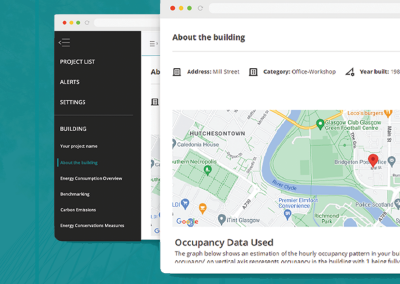Accelerate your net-zero journey with our
AI-powered platform for Real Estate
Trusted by leading companies
From energy data access to full decarbonisation,
learn more about our best-in-class four level approach…
Level 1: Data access and carbon reporting
Challenge:
- Data access: Accessing energy consumption data from your real estate portfolio is difficult due to tenant engagement barriers.
- Data coverage: Achieving 100% data coverage across a portfolio is complex and time consuming.
Solution:
- Data access: Get access to energy consumption data for your commercial real estate portfolio without the need for initial tenant engagement.
- Data coverage: Our proprietary technology is designed to identify the actual energy consumption for your portfolio, delivering up to 100% data coverage.
Level 2: Consent management
Challenge:
- Tenant engagement: Securing tenant consent to release building-level data across large portfolios can be complex.
- Managing the consent process: The complexities of green leases combined with asking tenants to sign multiple letters of authority become unmanageable at scale.
Solution:
- Tenant engagement: Engage tenants with quarterly reports that forecast and benchmark energy usage. This approach incentivises tenant participation by demonstrating clear, tangible benefits.
- Digital consent portal: Streamline the process with arbnco's portal for one-click frictionless consent.
Level 3: Decarbonisation strategy
Challenge:
- Net-zero targets: Companies face mounting pressure to achieve net-zero targets, with tight deadlines and high expectations from stakeholders.
- Complex property portfolios: The diversity in property types, sizes and locations creates uncertainty about where to start decarbonisation efforts.
Solution:
- Immediate performance analytics: With minimal additional data input, our platform provides instant performance analytics across multiple buildings. This helps you quickly assess current energy usage and pinpoint areas for improvement.
- Strategic benchmarking and planning: Benchmark energy performance across your portfolio and strategically plan capital investments, behavioural programs, or renewable energy assessments. Take decisive steps toward achieving your decarbonisation goals.
Level 4: Decarbonisation action plan
Challenge:
- Inefficient and costly audits: Manual energy audits by engineers are time-consuming and expensive, causing delays in taking action on energy efficiency improvements.
- Dynamic building simulation: Building digital twins of commercial buildings is hugely expensive and is a skilled process which is only feasible for the largest flagship buildings in a portfolio.
Solution:
- Calibrated energy modelling: arbnco enables dynamic, portfolio-wide modelling of buildings in just hours, delivering accurate, costed retrofit recommendations and optimised strategies for improved energy performance.
Request a demo
Schedule a demo with one of our product consultants.

















